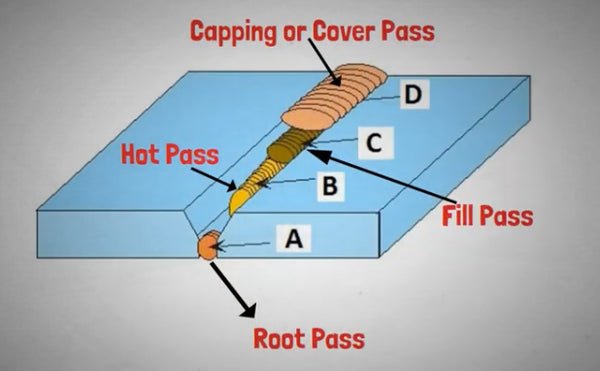A root pass in welding is the foundation of a strong and durable weld. It is the initial weld bead that fuses the two pieces of metal together at their root. This critical step ensures proper penetration and bonding for the entire welding process. Understanding what is a root pass in welding and mastering its technique is essential for creating high-quality and structurally sound welds. Let’s delve deeper into the significance and intricacies of the root pass in welding.
What is a Root Pass in Welding?
Welcome to our beginner’s guide to understanding what a root pass is in welding! If you’ve just started learning about welding, you may have come across this term and wondered what it means. Don’t worry; we’re here to break it down for you in simple terms.
Understanding the Basics
Before we dive into the specifics of a root pass, let’s first understand the basics of welding. Welding is a process used to join two metal pieces together by melting and fusing them. Think of it as a super strong glue made out of metal! Now, let’s take a closer look at what the root pass entails.
What is a Root Pass?
When two metal pieces are welded together, the first weld bead that is deposited to fuse the pieces is known as the root pass. It is like the foundation of a building; without a solid foundation, the rest of the structure won’t be stable. Similarly, the root pass is crucial in ensuring a strong and durable weld joint.
The Importance of a Root Pass
Now, you might be wondering why the root pass is so important. Well, the root pass not only helps in creating a strong bond between the metal pieces but also plays a significant role in ensuring the integrity and quality of the overall weld. Without a proper root pass, the weld joint may be prone to defects and failures, compromising its strength and reliability.
How is a Root Pass Made?
Making a root pass requires skill and precision. The welder carefully controls the welding equipment to deposit the first layer of filler metal into the root of the joint. This initial pass sets the stage for the subsequent welding passes that will follow to complete the weld joint.
Choosing the Right Technique
There are different techniques that welders can use to create a root pass, such as TIG welding, MIG welding, or stick welding. Each technique has its unique characteristics and benefits, so it’s essential to select the one that is most suitable for the specific welding project.
Common Challenges in Root Pass Welding
While the root pass is a critical aspect of welding, it can also present challenges for beginners. One common issue is ensuring proper penetration of the filler metal into the root of the joint. Inadequate penetration can weaken the weld joint and compromise its strength.
Overcoming Penetration Issues
To overcome penetration issues, welders must pay close attention to their technique and ensure proper heat control during welding. By adjusting the welding parameters and maintaining a steady hand, welders can achieve optimal penetration and create a sound root pass.
Inspecting the Root Pass
After completing the root pass, it is crucial to inspect the weld joint to ensure that the pass has been executed correctly. Visual inspection and testing methods may be employed to check for any defects or discontinuities in the root pass.
Quality Assurance
Quality assurance measures, such as non-destructive testing (NDT), may be utilized to verify the integrity of the root pass. This ensures that the weld joint meets the required standards for strength and durability.
Congratulations! You’ve now gained a better understanding of what a root pass is in welding and why it is essential for creating strong and reliable weld joints. Remember, the root pass forms the foundation of every weld, so mastering this fundamental aspect of welding is key to producing high-quality welds. Keep practicing and honing your skills, and you’ll soon become a proficient welder!
Stay tuned for more welding tips and tricks in our upcoming articles. Happy welding!
Root Pass, Hot Pass, Fill and cover Passes in welding
Frequently Asked Questions
What is a root pass in welding?
A root pass in welding is the first weld bead or layer deposited when joining two pieces of metal together. It is usually done along the joint to ensure proper penetration and fusion between the base materials.
Why is the root pass important in welding?
The root pass is crucial in welding as it establishes the foundation for the entire weld. It ensures that there is proper bonding between the two materials, creating a strong and durable weld joint.
How is a root pass different from other welding passes?
A root pass differs from other welding passes as it focuses on penetrating deep into the joint and creating a solid bond at the root of the weld groove. It is typically the most critical pass in ensuring the overall quality of the weld.
What are some common challenges faced while executing a root pass in welding?
Some common challenges when executing a root pass include achieving proper penetration, controlling the heat input to prevent distortion, and ensuring uniformity and cleanliness of the weld joint.
Can the root pass be done using different welding processes?
Yes, the root pass can be done using various welding processes such as shielded metal arc welding (SMAW), gas tungsten arc welding (GTAW), flux-cored arc welding (FCAW), and gas metal arc welding (GMAW). The choice of process depends on factors like material type, joint configuration, and welding requirements.
Final Thoughts
In welding, a root pass is the first weld bead deposited to establish a strong foundation for subsequent weld layers. It is crucial for ensuring proper penetration and fusion between the base materials. Proper preparation and execution of the root pass are essential for the overall integrity of the weld. Understanding what a root pass in welding is and following correct procedures are vital to achieving high-quality welds that meet industry standards.




